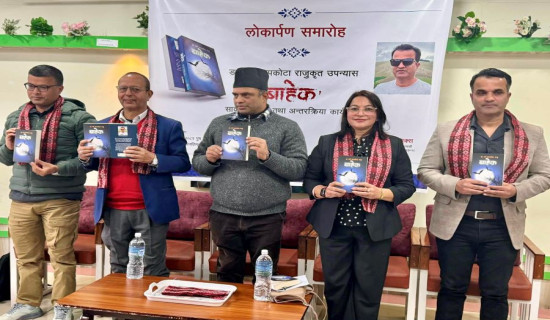- Saturday, 20 December 2025
Attend To Road Accident Victims
Accidents will happen. So goes the proverb.
Transport is an essential part of human life. The growth of motorised transport has provided convenience for people. The lifestyles of people have also changed. However, transport also has some drawbacks as it causes air pollution through the emissions of exhaust fumes and accidents, resulting in injuries or deaths. Such accidents are termed road traffic accidents (RTAs). RTAs are a burden not only on the victims but also on the state. As per a study, it is estimated that the economic burden of RTAs in low- and middle-income countries is 1-1.5 per cent of the gross national product. Economically vulnerable RTA victims find it heavy going to manage treatment. Sometimes, RTA victims have to lead a disabled life, which is a misfortune for them.
RTAs have been declining in high-income countries in recent decades, whereas they are increasing in low- and middle-income countries like ours. Casualties constitute around 90 per cent of all RTA deaths and disabilities globally. Likewise, RTAs represent the eighth leading cause of death globally. Over 1.35 million lives are lost and 50 million non-fatal injuries are sustained owing to RTAs on an annual basis. Among the RTA victims, over half of the casualties are pedestrians, cyclists and motorcyclists. In most low-income countries, most motorised two-wheeler riders are prone to death, followed by four-wheeler and heavy vehicle drivers.
Protocol of rescue
As per the survey of the Global Burden of Diseases (2017) regarding RTA deaths in Nepal, pedestrians top the death toll, followed by motorcyclists and motor vehicle drivers. Youths are more likely to be killed or injured in RTAs. In Nepal, vehicles are increasing day by day. Road accidents occur for various reasons such as rash and negligent driving, overloading, speeding, driving under the influence of alcohol or drugs, the bad condition of roads and the bad condition of vehicles. Traffic has to be managed by deploying traffic cops along the roads as there is not automated traffic management system. There are traffic rules, but some vehicles do not follow the rules. That is why, traffic cops penalise erring vehicles in large numbers. What is more, some pedestrians also do not follow the traffic rules: they tend to cross roads from anywhere and they do not use pavements or road bridges. Such pedestrians are also to blame for increasing RTAs in the country.
In recent times, some measures have been taken to prevent RTAs in Nepal. CCTV cameras have been installed at various road junctions. Speed limits have been enforced to reduce speeding. For example, vehicles running along the Ring Road are not permitted to exceed 50 km per hour. The speed of vehicles is constantly monitored. The breath test of motorcyclists and drivers through breathalysers or otherwise has been in vogue for many years. This has drastically reduced the number of RTAs. Other steps taken to reduce RTAs include enforcing the rules regarding wearing seatbelts and restricting the use of mobile phones while driving. The compulsory wearing of helmets for pillion riders is also being mulled.
RTAs claim the lives of more people than those of the victims of floods, landslides, air crashes and other accidents combined. Most RTAs are concentrated in the Kathmandu Valley and in the Terai belt. RTAs are the most common cause of injuries and trauma in Nepal. It is possible to prevent, or at least mitigate, RTAs if proper arrangements are made. Motorcyclists and drivers should be careful while riding and driving; their vehicles should be in condition (there is provision for fitness tests for public vehicles); pedestrians should also abide by the traffic rules; and roads should be properly maintained. Moreover, there should be a policy regarding road safety.
When an accident occurs, the victims should be taken to hospital as quickly as possible. In Nepal, pedestrians or police tend to attend to such victims. They do not have proper equipment to rescue the victims. And they do not know the protocol of rescue. They use whatever device is available at accident sites. They are not trained in emergency response mechanisms. So even non-fatal injuries may worsen. There is a lack of trained rescue and emergency first responders. There should be provision for rescue and emergency services as well as paramedic services so as to attend to the RTA victims.
Rehabilitation care
Hospitals are concentrated in big cities such as Kathmandu, Bharatpur, Pokhara and Nepalgunj. In remotes parts of Nepal, hospitals are glaringly lacking. The people there have to make do with primary clinics. Most RTA victims need trauma care. They have to be attended to by orthopaedists or orthopaedic surgeons. For lack of trauma centres, the victims have to be transported, either by road or by air, to the cities where there are better health facilities for specialised surgery or emergency treatment. The cost of transport involved in such rescue is huge. Air lifting is even more expensive.
It is a no-brainer that deaths can be prevented, critical injuries can be treated and disabilities can be prevented if emergency services or trained medical professionals can reach accident sites in time and take them to hospital. They can identify the level of treatment required and treatment can be administered on the basis of triage. The government should establish at least one well-equipped hospital with emergency and trauma services in all the districts. This will obviate the need for transporting RTA victims to Kathmandu or other medically equipped places. Police and traffic police should also be trained as first responders in first aid and basic emergency medical care. It may be noted that after recovery, the victims may need rehabilitation care so that they may not face long-term complications. Therefore, it behoves the government to pay heed in this direction also.
(Maharjan has been regularly writing on contemporary issues for this daily since 2000.)

















